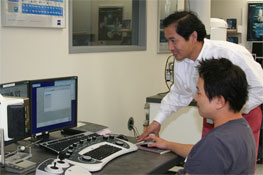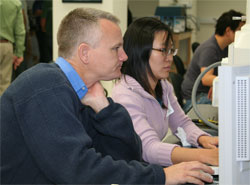UCI Faculty, Lab Staff Get Crash Course in Advanced Microscopy
Oct. 26, 2006 -- UC Irvine faculty, lab staffers, graduate students and postdoctoral researchers became better acquainted with the Carl Zeiss Center of Excellence in the Calit2 Building this week. A one-day workshop facilitated by Dan Mumm, assistant professor of chemical engineering and materials science, microscopist John Porter and Zeiss personnel familiarized the more than 30 enthusiastic participants with the three scanning electron microscopes and their various capabilities.
|
The participants represented departments campus-wide, including anatomy and neurobiology, ecology and evolutionary biology, chemistry, biomedical engineering, brain aging research, civil and environmental engineering, and the Beckman Laser Institute. Also attending was William Cooper, the newly appointed director of UCI’s Urban Water Research Center.
The students-for-a-day got an overview of the Zeiss lab in the morning session, as well as a tutorial about each of the three SEM microscopes and their capabilities.
They learned the specifics of each SEM – from the EVO with its environmental chamber pressure capability for examining wet specimens to the Ultra 55 with its higher resolution and high vacuum requirement.
|
After a catered lunch in the Calit2 Atrium, the group got one-on-one time with the microscopes, watching demonstrations and working with their own samples to learn first-hand how the lab can facilitate their research.
Noo Li Jeon, assistant professor in the Department of Biomedical Engineering, said he found the workshop very useful. “It made me think about projects that could become possible with the new equipment,” he said, adding that now that he is familiar with the Zeiss Center of Excellence, he “definitely” plans to use it in his own research.


